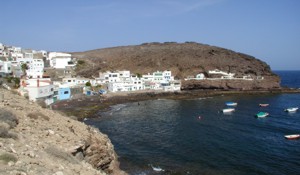


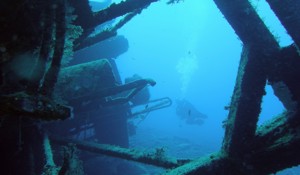
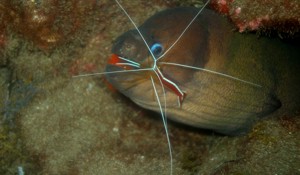
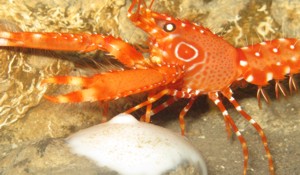
Gran Canaria has a fantastic selection of scuba diving and
snorkelling sites which will delight divers of all levels and
abilities. There are sheltered bays and coves where you can take an
experience or training dive, or deeper wrecks where more
experienced divers can explore. As you travel around the islands,
there are a number of main dive sites which visitors explore on a
regular basis.

The best diving area on the island is unquestionably the Arinaga
Marine Reserve on the east coast, known better as 'El Cabrón',
where divers from most of the major dive schools can be found every
day of the week. Working towards the south there are several
possible entries but these are onto unremarkable shores with
variable visibility and little life.
Once past the sandy beaches of Maspalomas and the southern tip of
the island, the west coast offers numerous coves and bays between
Pasito Blanco and Mogan, and a few off-shore dive sites such as
Pasito Blanco, which provide a variety of relatively easy dives at
depths of 15 to 25 metres, and several small wrecks to dive
on.
The north-west coast is largely unaccessible, but also subject to
strong swells and the northerly trades and so rarely dived, with
only Sardina del Norte being used on a regular basis.
Finally at Las Palmas, in the North East. the best wreck diving can
be found, with La Catedral and Barra de Las Canteras being the
other most significant dives. Working clockwise around the coast,
it is possible to dive from several bays, inlets and small beaches
(though mostly unremarkable). The Gando Shoal has some interesting
wrecks, but at present there is no dive school or boat which goes
there on a regular basis.
In July 2005 Gran Canaria was declared a World Biosphere Reserve by
the UN, and several areas both inland and around the coast have
been listed by the EU as Sites of Special Scientific Interest, but
to date only the 'El Cabrón' area has formally been proposed to the
Ministerio for the status of Marine Reserve.
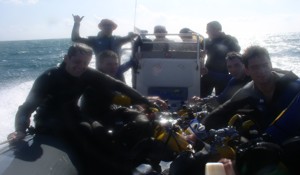
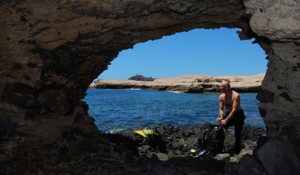
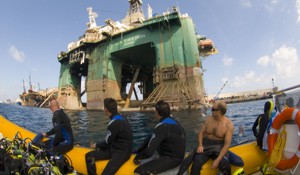


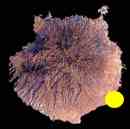
Playa Del Ingles - 20 mins
Puerto Rico - 40 mins
Mogan 1hr
![]() Reef Diving
Reef Diving
![]() Cavern
Diving
Cavern
Diving
![]() Night Diving
Night Diving
![]() Shore
Diving
Shore
Diving
This area on the east coast has developed such a reputation for the variety and quantity of marine life that it has not only been proposed as a marine reserve, but an underwater guidebook has already been produced by the local council. It is currently in the final stages of approval as a Micro Area Protected Marina
The underwater marine life is prolific, with huge shoals of
roncadores, damselfish, sardines, bream, and baracuda, other
species such as wrasse and parrotfish are common throughout
the reserve. Every dive can throw up surprises, from rays, to
sea-horse, from glass-eye to gorgonias. You can see several
of the species only found in the canaries including many Bart
Umbrines (Cernia Rossa).
But it is not just the marine life which makes this area
special, as the underwater scenery is stunning, with natural
arches, caves, tunnels, swim-throughs and cliffs. From the
main entry point there are at least four different dive
routes, and altogether between eight and ten seperate dives
in the reserve.
If you are only going to do a couple of dives on the island,
then this is the place to head for. However despite the
beauty and colour under the water the reserve itself is at
the end of a dusty 'off-road' track with no visitor
facilities at all (no toilets, no water, no cafes nothing).
The best dives bottom out at around 22m, and are
'multi-level' which means that if you are careful with your
air you can safely complete non-stop dives of 40+
minutes.
For more information on the individual dive sites in the
Arinaga Marine Reserve see the special write-up on the
website of the only major diving centre in Arinaga:
Dive Sites in the El Cabrón Marine Reserve
For more information from the local environmental group,
Patinegro, see a translation of their leaflet Playa del
Cabrón - Una costa de Vida


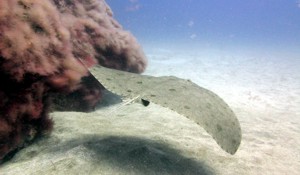
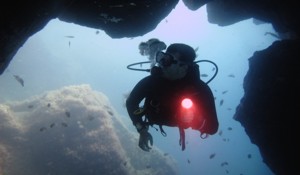

Playa Del Ingles - 20 mins
Puerto Rico - 5 mins
Mogan 20 mins
![]() Reef Diving
Reef Diving
![]() Boat Diving
Boat Diving
This is a boat dive to a reef about 2km from the shore just off the southern point of the island. This is probably the best scenic dive on the South and West coast of the island. The reef is at a maximum depth of 19m and rises between one and three meters from the sand, and is roughly circular, so can be circumnavigated on one tank of air. There is a large shoal of roncadores (bastard grunts), and stingrays are fairly common. You are also likely to see trumpetfish, baracuda, filefish, black-tailed combers, morays, marmor bream and smaller reef species such as damselfish and wrasse.
This is a boat dive to an artificial reef about 5km from the shore. The reef has been created on a sandy sea bed by dropping several artificial structures including blocks, tubes and concrete 'skeletons'. The area is the home to a large shoal of roncadors, barracudas, and is a good place to find angleshark and ray.

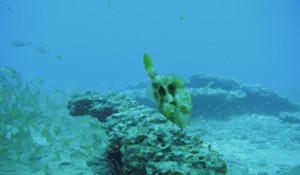
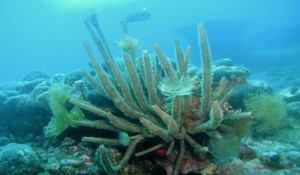
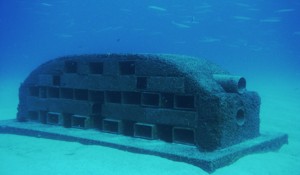


Playa Del Ingles - 15 mins
Puerto Rico - 10 mins
Mogan 10 mins
![]() Reef Diving
Reef Diving
![]() Boat Diving
Boat Diving
Just outside the harbour at Arguineguín, this reef lies in 14-16m and has a large permanent shoal of roncadores. Stingray, trumpetfish, morays and other common reef dwellers can also be found. Following the edge of this volcanic reef you come can hunt among the nooks and crannies for smaller species, until you arrive at the fish-ball, which will part to let you pass and then reform behind you.
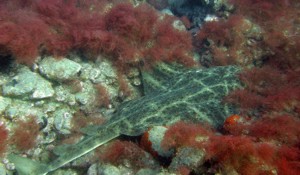

Playa Del Ingles - 25 mins
Puerto Rico - 5 mins
Mogan 10 mins
![]() Reef Diving
Reef Diving
![]() Cavern
Diving
Cavern
Diving
![]() Night Diving
Night Diving
![]() Shore
Diving
Shore
Diving
There are several smaller bays along the west coast where
shore diving is possible, and you can enter the water from
the beach if there is no swell. Most of these beaches are quite steep and stony,
and have a breakwater zone where visibility can be quite
poor. Once outside this zone rock-strewn shores are common
with a variety of the more common species such as damselfish,
parrotfish, wrasse and bream. The beach at Amadores is of
imported coral-sand behind the breakwater, and this can get
very cloudy if there is an onshore wind or strong
groundswell. The undeveloped beach at Medio Almudh is
suitable for shore diving and snorkelling, however it is also
the local nudist beach! Some of the beaches such as Taurito have jet-skis or other water sports,
so make sure you enter in the designated areas.


Playa Del Ingles - 30 mins
Puerto Rico - 10 mins
![]() Reef Diving
Reef Diving
![]() Cavern
Diving
Cavern
Diving
![]() Night Diving
Night Diving
![]() Boat
Diving
Boat
Diving
![]() Wreck
Diving
Wreck
Diving
Puerto de Mogan is the last and most important of the small harbours along the South West Coast. From here is is possible to dive with several operators, and here the wreck of the 'Cermona II' is one of the most important dive spots. The wreck lies in about 18m of water and was originally a small coastal trader and fishing boat. It was sunk as an attraction for the 'Yellow Submarine' which comes out of Mogan Harbour roughly every hour, and makes a circuit of this and the other now broken up wreck in the area. This provides a double bonus for divers as it is rare to be able to say that you have dived alongside a submarine, and if the family don't dive they can always watch you from inside the submarine.
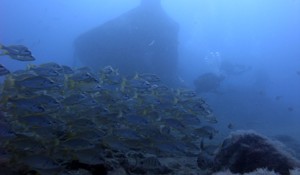


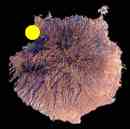
Playa Del Ingles - 1hr 30 mins
Puerto Rico - 1hr 50mins
Mogan 2hr 15 mins
![]() Reef Diving
Reef Diving
![]() Cavern
Diving
Cavern
Diving
![]() Night Diving
Night Diving
![]() Shore
Diving
Shore
Diving
These two dive sites, and Puerto de la Nieves, are all on the opposite corner of the island to the popular tourist resorts of the south and west, making it a drive of almost 100km to get here. Few tourists therefore visit these dive sites, which are shore dives down to aproximately 18m. However those that take an excursion here are rewarded with a wide range including all the typical harbour species of wrasse, damselfish, mullet, octopus and cuttlefish along with a good mix of bigger species including angelsharks, butterfly rays and other rays.
Sardina del Norte has probably the easiest shore dive entry in Gran Canaria .. you walk down a set of good quality stone steps and get straight into water 3-4m deep, with a giant stride if you want, where you will immediately find wrasse, blennies, damselfish and bream.
Caleta del Abajo is another shore dive with some nice
underwater caves, overhangs, gullys and caverns to explore.
This area has not been effected by Sea Urchins in the same
way as some of the more southerly dive sites, and so has a
different mix or marine algeas and a rich set of
invertebrates that graze them including nudibrachs, sea hares
and sea slugs. However it is in the Autumn when most people venture North as
Manta Rays (Mobula mobula)feed in this area and are frequently seen by
divers.
Puerto de la Nieves (Agaete) is the terminus of the
ferry to Tenerife, and from the beach it is possible to
snorkel a long way out without dropping into deep water.
Parking near the beach is very limited, and there are no dive
schools in this area, making it once again a very long drive
from the resorts of the South.
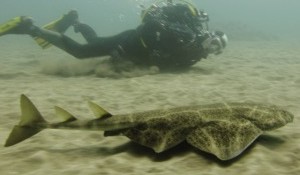

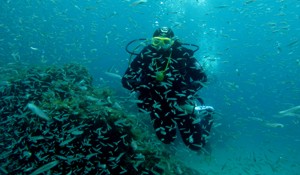
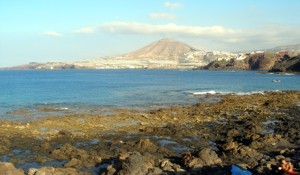
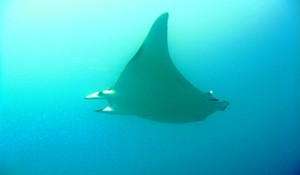

Playa Del Ingles - 40 mins
Puerto Rico - 60 mins
Mogan 1hr 20 mins
![]() Reef Diving
Reef Diving
![]() Wreck Diving
Wreck Diving
![]() Cavern
Diving
Cavern
Diving
![]() Night Diving
Night Diving
![]() Shore
Diving
Shore
Diving
![]() Boat Diving
Boat Diving
La Catedral
Lying just outside Las Palmas,this dive
can only be reached by boat, and only when the wind and tide
conditions are favourable - on one of those rare days when
the north-easterly trade winds are not blowing, and there is
no on-shore swell. This is a cavern dive where you descend to
the sea-bed at 12-14m, then through large natural hoes into
the cavern below. The cavern then stretches down to an
amazing 45m, with light streaming in through the entry points
above you in the roof. The underwater geology is spectacular,
and here you can expect to find prawns, crabs and other
inhabitants of limited light. This is a dive for those with
more experience, particularly if there is an swell
running.
Las Palmas probably has the best wreck diving in the whole of the Canaries. The Angela Pando at 200m long is one of the biggest, but the Arona is one of the most spectacular. There are other wrecks such as the Frigorifica, and Little Kalais, and for many years the Kalais was very famous, but is now inside the new harbour and diving there is severely restricted.
The Arona rests just outside Las Palmas to the South, this is
the wreck of a hundred-meter long cargo vessel, which sank while under tow
in the 1980's. It sits on its side on the sea bed and is
in an excellent state of preservation, and still boasts many
artifacts and equipment. It is now the home to very big
schools of barracudas above, with a shoal of bastard grunts and damselfish
swimming around the king
post which can be followed to the deck at 25
meters. Here you can enter the holds. At the stern the engine compartment is open and you can see the majority of
the main machinery. For those divers qualified in wreck diving
there are some penetrations, but for most divers the sheer scale of the wreck and the abundance of life make it a dive not to be forgotton.
Other wrecks which are worth exploring include the Frigorifica, the
Angela Pando (at 200m long probably the biggest wreck in the Canaries), the Upside-Down wreck and the Tres Barcos
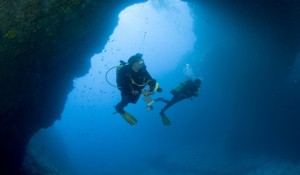

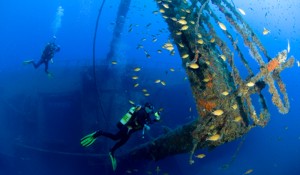

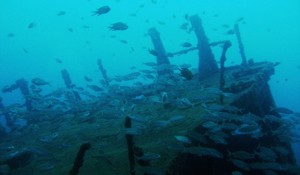
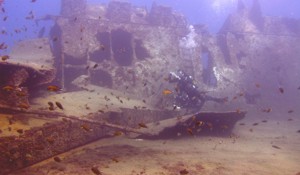
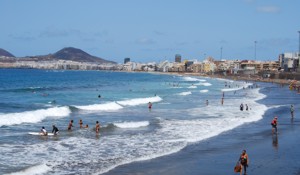
On the north side of Las Palmas is a long beach, Playa de
Las Canteras, which is protected from the usual northerly
swell by a small reef. If conditions are suitable it is
possible to swim out from the beach and explore the reef,
which reaches a maximum depth of 8m. You will find most of
the smaller species such as damselfish, wrasse, bream. This
site is better for snorkelling than diving due to access and
tide conditions.
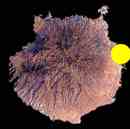
Playa Del Ingles - 30 mins
Puerto Rico - 50 mins
Mogan 1hr 10 mins
![]() Reef Diving
Reef Diving
![]() Night Diving
Night Diving
![]() Shore Diving
Shore Diving
There are several bays where shore diving is possible along the north east coast. If weather conditions are suitable you can dive these divesites which are much quieter than the more popular diving destinations such as Arinaga. At Taliarte near to Playa de Salinettas you can dive down to see a field of Gorgonias at 30m, while at Tufia, there are several entry points for snorkelling and diving down to 8-10m.
The Bay of Gando (next to the Airport) is a military area and
is closed for diving, however just outside the bay, on the
Gando Shoal there are several wrecks that can only be reached
by boat, including the wreck of the Alphonso XII in 60m of
water where it is rumoured you can still find gold
coins!
